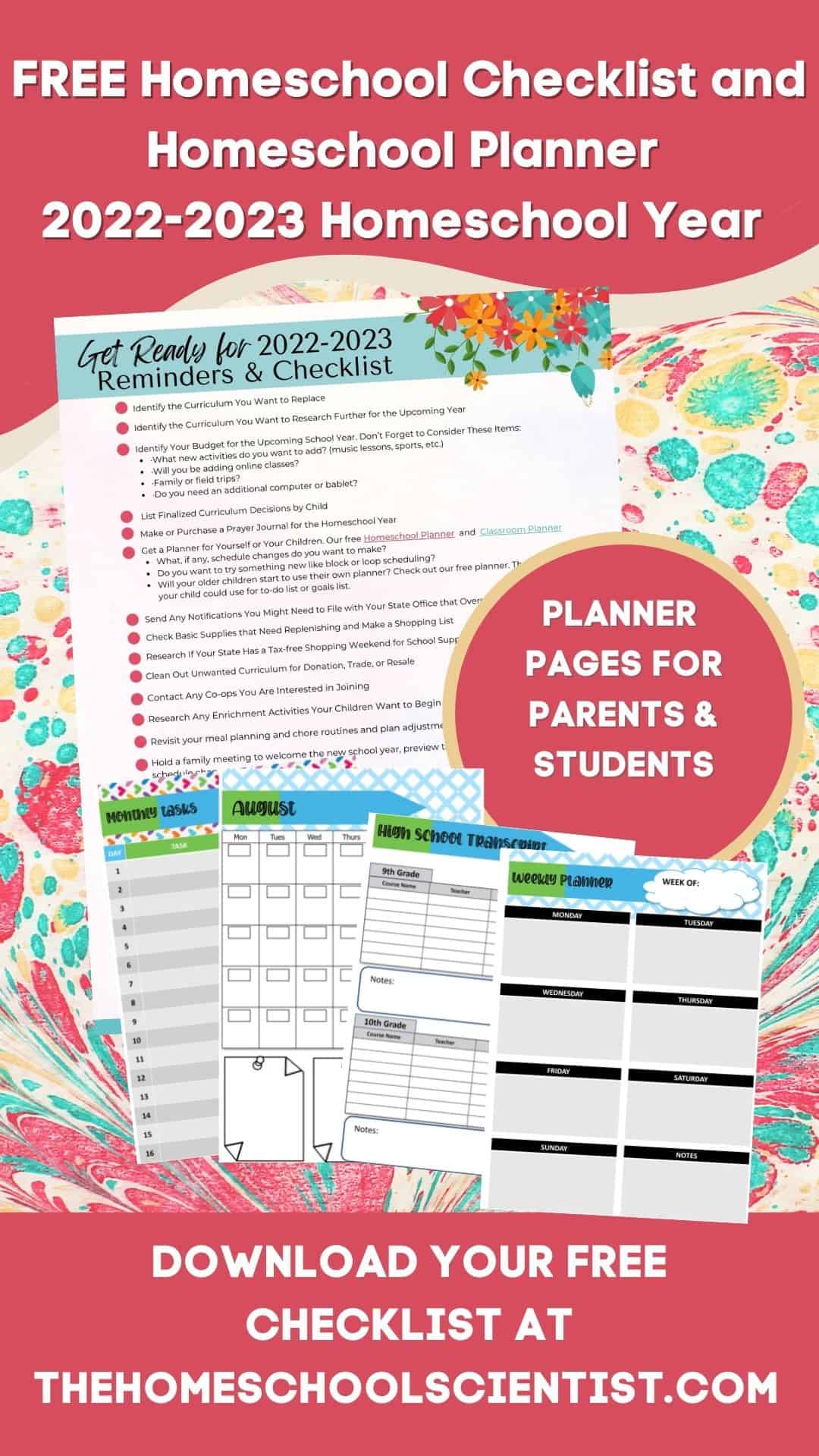How to Homeschool – Preparing for a New Homeschool Year
Whether you are gathering information on how to homeschool or you currently homeschool and are preparing for a new homeschool year, preparing for a new homeschooling year starts before the current academic ends.

As we move through the current academic year, there are times when we make mental or physical notes about things in our child’s homeschooling we want to change or a different way of approaching a challenge in our schedule or curriculum. If you are new to homeschooling, reflect on your child’s education in traditional school. What worked, what sparks your child’s interest, how does your child learn?
This type of evaluation is an important step each year and not just after the first homeschool year. Get in the habit of going through the checklist below prior to the upcoming school year. Schedule time over the summer months to take an extended break, relax, and look back on the previous year once refreshed.
Think of it as a refresher course on how to homeschool that helps you improve and adjust as each of your children grows and matures.
And that’s one of the beautiful things about being a homeschool parent, we can adjust and tailor how we homeschool and the resources used.
We changed math curriculum often with my youngest, who has an official diagnosis of dyscalculia. Preparing for a new homeschool year typically meant I spent extra time researching math curriculum, tutors, local math classes, and finding fun things to try like hands-on games and activities.
So, what areas do you need to give extra attention to when getting ready for a new homeschool year or getting ready to start homeschooling for the first time.
If you have just left public school and this is your first year homeschooling, use this list to help you get ready to start the new year as a first-time homeschooler. Honestly, learning how to homeschool doesn’t happen in the first year of homeschooling or even the second or third year.
Throughout our years of homeschooling we are always learning how to homeschool each of our children.
So, take a deep breath, and let’s dig in.
How to Homeschool – Getting Ready and Preparing for the Start of a New Homeschool Year
- Evaluate What Worked and What Didn’t in the Previous Homeschool Year
As you prepare for the new homeschool year, the first thing to do is drop what didn’t work. Was there a single curriculum that caused frustration?
One year we tried a web-based math curriculum; it lasted one week. Yup, one week. It wasn’t flexible enough and didn’t work with my child’s learning style. It was painful and not worth trying to make it fit.
These changes don’t just apply to curriculum and resources; you may need to change HOW you homeschool? Consider these questions:
-
- Does your homeschool philosophy and approach match your child’s learning style? Is there too much bookwork and not enough hands-on activities? Take some time to research various homeschool methods, like the Charlotte Mason approach.
- Do you need to set goals for the week rather than trying to adhere to an hour-by-hour daily schedule? My struggle was trying to plan our homeschool day in 30-minute and 60-minute increments. In our last four years of homeschooling, we set assignment goals for the week and didn’t put any other time restraints on assignments. This helped teach planning, independence, and accountability.
- There are many ways to set a homeschooling schedule, so try different options, be flexible, and you will find the best way to homeschool for your family.
- Would your homeschool benefit from a curriculum or resource that allows your teen to work independently? One of the best things I did for our homeschool was ask my oldest what he wanted to study in school the summer before third grade. His response was, “Build a robot.” This was a pivotal change in our worksheet-after-worksheet-after-worksheet approach to homeschooling and changed the course of our homeschool (and his career after high school.) So, include your children when planning and preparing to start a homeschool year.
- Do you need to change where your homeschool space is located? Especially as our children get into middle and high school, they may no longer need or want to homeschool at the kitchen table or dining room table with younger siblings. If your teens are in live online classes, they may need a quiet space. More advanced courses may require extra-focus and time to work away from a bustling homeschool room.

- Talk with your spouse and children about the homeschool year that is coming to a close and the upcoming year to gather ideas and improvements on how to homeschool in the upcoming year(s).
-
- What do they think worked, and what was the best part of their year? When did they have a great time in their academic year?
- What would they like to study during the next academic year?
- If you have a high school student, where are they on your state laws regarding graduation requirements? We have a section below on high school-specific things to do before starting the new homeschool year.
On your to-do list for the new homeschool year, add the task of researching a new curriculum or resource for what didn’t work, but you need to cover.
If a resource didn’t work, either save it for another child whose learning style might fit the curriculum, donate it to a family in need, or resell it.
- Identify your budget for the upcoming homeschool year. As you think through what you’d like the new homeschool year to look like, consider these questions too:
-
- Is there a new thing you want to add to your homeschool? Are there any subjects you are adding for a high school graduation requirement?
- Will you be using an online class or a digital resource? What is the price of the online class, and will you have to pay all at one time, or is there a payment plan?
- Do you need another computer or tablet to accommodate the addition of an online or digital curriculum?
- Are there any field trips or educational family trips you want to plan? Check out the Homeschool Road Trips for some amazing educational family experiences.
- List out the new homeschool curriculum for each child and cost breakdown. Are there any classes you can combine? Also, are there curriculum resources that offer a family price? CTC Math offers a VERY affordable price for families (and you can move onto the next grade level if you finish in less than a year.)
- Get a prayer journal and a planner. It’s helpful to make a plan to have a homeschool schedule starting point for the year, month, and week. But that prayer journal… as it is filled throughout the homeschool year, it’s going to remind you that God’s plan is sovereign. Our most valuable lessons are learned when we place our struggles, victories, and questions before Him.
A planner is a starting point for the year, month, and week, but the ending point will be different, and God controls what’s between those two points. God will show you how to homeschool the best way for your family.
- Before starting the new homeschool year, check your state’s homeschool laws and regulations. Each state is different, so get this done if you need to register with an umbrella school or check-in with an agency or organization. If you aren’t sure, do the research. HSLDA also has state-by-state information.
- Find out if and when your state’s tax-free school shopping weekend is scheduled to occur. If your state offers this, read the fine print. If computers are included, and you’re going to need one, it may be the ideal time to make that purchase.
Also, make a list of school supplies you need.
- Research co-ops and enrichment classes in your area for the coming year. Actually, this should be done WAY before the start of the next homeschool year. In our experience, co-op classes fill quickly.
This also includes researching any new lessons your child wants to take—music, art, martial arts, etc. These expenses need to be added to your budget and the gasoline to get there.
- Revisit your household chore schedule and meal prep. Now may be an excellent time to reassign chores or add new recipes. Maybe try freezer cooking or bulk cooking. Jamerrill at Large Family Table is my favorite resource. Even if you do not have a large family, her recipes and strategies still apply.
- As you get closer to starting the new homeschool year, hold a family meeting to pray over and talk about the new homeschool year. This is a good time to create or review the mission statement for your homeschool. If your curriculum is in, have your children browse their new school books and resources. Answer questions your children may have about the daily routine, curriculum, and new activities. Discuss any possible routine changes. Discuss expectations.
But, homeschool mom, it’s important to recognize that these are all part of a basic plan, a starting point for the new year; it will change. It’s perfectly normal to try different things–schedules, curriculum, the physical arrangement of supplies, how you store everyday books, etc.
How to Homeschool – Preparing for Homeschooling the High School Years
If you’re getting ready to start homeschooling a high school student this year (or any year of high school), here’s a checklist based on our go-around through high school.
- Know your state’s high school graduation requirements and refer to them every year. If you have any questions, get answers from your state’s office that oversees homeschooling. What applied to one child may not apply to the next. For example, an earth science course in high school was required when my oldest was in high school, but seven years later didn’t apply for our next child. So, do verify graduation requirements every year.
- Update your teen’s high school transcript after each course is completed. Also, you may want to take a photo of or make copies of the textbooks used and the Table of Contents. I recommend this because I’ve heard stories of people needing to provide information to colleges on curriculum. However, we have never encountered this in our college application process.
- Review your high school student’s 4-year course of study. What have they taken and what do they plan to take. Their interests may change and their post-graduation plans, so review electives, science, and math courses they have taken and want to take in their remaining high school years.
- Your teen should update their resume with volunteer work, paid work, internships, activities, awards, or projects. Updating a resume after the school year avoids rushing at the last minute to put one together. Plus, the information will be ready for job and college applications.
- Is your teen eligible and ready for driver’s education? In our state, teens have to take a class from an approved teacher and have a certain number of practice hours. So, research your state’s laws.
- If dual enrollment at a community college is possible, start researching it. Is there a fee? Is there an entrance exam, and how often is it offered?
- Are there apprenticeship partnerships in your area via private businesses or community colleges? In our STEM Resource Guide for Parents, we cover some information on this growing and popular movement. It’s inspiring to see what opportunities have opened up for our teens!
- Gather SAT and ACT testing information and dates ahead of time. Consider taking it several times.
- Gather early acceptance and regular deadlines for college applications? Do you need to schedule any campus visits this summer or during the homeschool year?
Download the FREE Getting Ready for the New Homeschool Year Checklist and FREE Homeschool Planner
We have created a PDF checklist of things to do to prepare to start homeschooling this upcoming year. If you’re new to homeschooling and looking for help to start homeschooling, grab our checklist and FREE planner.
We designed these resources based on our 22 years of homeschool experience. What we’ve learned is that each year we are learning new strategies related to how to homeschool in a way that best fits our children.
Input your email address and join our newsletter community, and we’ll get the checklist right to you!
PLUS, we’ll send you our homeschool planner. Our planner even has a weekly task list for your children to start using. Keep it simple for them, especially if they are just getting started with a planner of any type.

I hold a master’s degree in child development and early education and am working on a post-baccalaureate in biology. I spent 15 years working for a biotechnology company developing IT systems in DNA testing laboratories across the US. I taught K4 in a private school, homeschooled my children, and have taught on the mission field in southern Asia. For 4 years, I served on our state’s FIRST Lego League tournament Board and served as the Judging Director. I own thehomeschoolscientist and also write a regular science column for Homeschooling Today Magazine. You’ll also find my writings on the CTCMath blog. Through this site, I have authored over 50 math and science resources.



